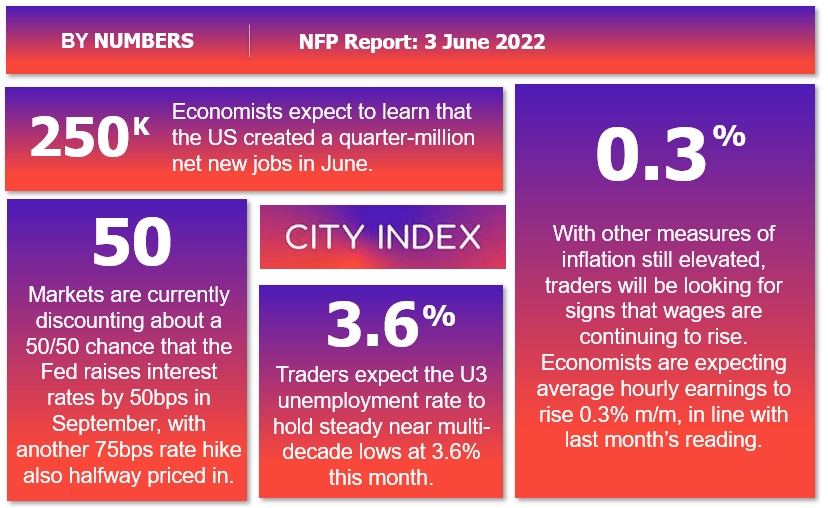
NFP Insight
In last month’s NFP preview report, we noted that the US jobs market was, “still producing a consistently solid number of new positions, with employers competing to offer compelling wages to attract talent. Against that backdrop, the Federal Reserve is committed to rapidly tightening monetary policy to ensure that inflation doesn’t become entrenched in a wage-price spiral higher.” While that dynamic is still at play to an extent, it’s worth noting that traders and economists are expecting a sizable slowdown in US employment growth: For the June NFP report, consensus expectations are for just 250K net new jobs and average hourly earnings projected to rise by 0.3% month-over-month:

Source: StoneX
If the report meets these expectations, it would be the slowest net jobs growth since December 2020’s outright decline of -227k jobs.
Are the expectations for NFP justified? We dive into the key leading indicators for Friday’s critical jobs report below!
NFP forecast
As regular readers know, we focus on four historically reliable leading indicators to help handicap each month’s NFP report, but due to ADP’s decision to pause releasing its employment report while it revamps its methodology, we only have three leading indicators this month:
- The ISM Services PMI Employment component came in at 49.1, up a bit from last month’s 47.4 reading, but still in contractionary territory (<50)
- The ISM Manufacturing PMI Employment component rose to 49.9, once again up from last month’s reading (47.3) but not quite in positive territory
- Finally, the 4-week moving average of initial unemployment claims rose to 255K, up from last month’s 233K reading
As a reminder, the state of the US labor market remains more uncertain and volatile than usual as it emerges from the unprecedented disruption of the COVID pandemic. That said, weighing the data and our internal models, the leading indicators point to a slightly below-expectations reading in this month’s NFP report, with headline job growth potentially coming in somewhere in the 150K-250K range, albeit with a bigger band of uncertainty than ever given the current global backdrop.
Regardless, the month-to-month fluctuations in this report are notoriously difficult to predict, so we wouldn’t put too much stock into any forecasts (including ours). As always, the other aspects of the release, prominently including the closely-watched average hourly earnings figure which came in at 0.3% m/m in the most recent NFP report.
Potential NFP market reaction
|
|
Wages < 0.2% m/m |
Wages 0.2-0.4% m/m |
Wages > 0.4% m/m |
|
< 150K jobs |
Bearish USD |
Slightly Bearish USD |
Slightly Bullish USD |
|
150K-350K jobs |
Slightly Bearish USD |
Slightly Bullish USD |
Bullish USD |
|
>300K jobs |
Slightly Bullish USD |
Bullish USD |
Strongly Bullish USD |
The US dollar index peaked near 109.00 midway through last month before pulling back to its 50-day EMA over the latter half of July. Earlier this week, the index put in a large bullish engulfing candle off that support level, signaling that the longer-term uptrend may be resuming. With rates finding support at a logical level and no longer overbought, our bias is tilted toward more strength in the greenback in the wake of the NFP report.
As for potential trade setups, readers may want to consider GBP/USD sell opportunities on a stronger-than-expected jobs report after the Bank of England’s forecast for an outright recession and 13% inflation at this week’s meeting. This week’s bearish reversal in the pair suggests that the longer-term downtrend has likely reasserted itself for a move back down below 1.2000.
On the other hand, a soft jobs report could present a sell opportunity in USD/JPY. The pair has shown a prolonged bearish divergence with its 14-day RSI indicator, showing waning buying pressure over the last few months, and prices finally appear to have broken below support at the 50-day EMA late last week.
How to trade with City Index
You can trade with City Index by following these four easy steps:
-
Open an account, or log in if you’re already a customer
• Open an account in the UK
• Open an account in Australia
• Open an account in Singapore
- Search for the market you want to trade in our award-winning platform
- Choose your position and size, and your stop and limit levels
- Place the trade






